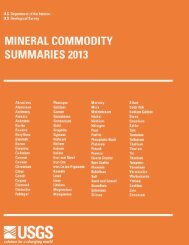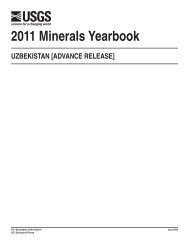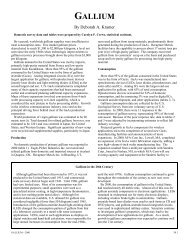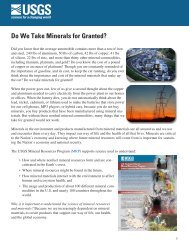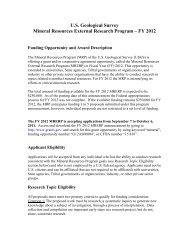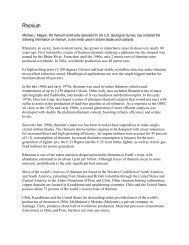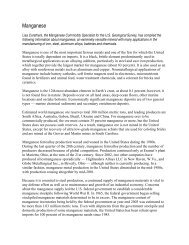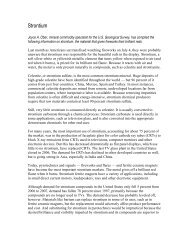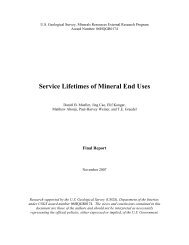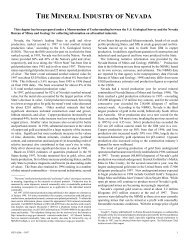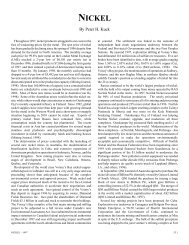Mineral Commodity Summaries 2003 - Mineral Resources Program ...
Mineral Commodity Summaries 2003 - Mineral Resources Program ...
Mineral Commodity Summaries 2003 - Mineral Resources Program ...
You also want an ePaper? Increase the reach of your titles
YUMPU automatically turns print PDFs into web optimized ePapers that Google loves.
6<br />
SIGNIFICANT EVENTS, TRENDS, AND ISSUES<br />
The <strong>Mineral</strong> Sector of the U.S. Economy 1<br />
Following the recession of 2001, restrained consumer<br />
spending, declines in domestic manufacturing and<br />
industrial output, and increased unemployment led to an<br />
expansion of only about 2% in the domestic economy<br />
during 2002. Significant production declines in the U.S.<br />
metals industry were registered by copper, lead, and<br />
zinc producers. Steel producers, despite a slight<br />
improvement in output, continued to face strong foreign<br />
competition, higher energy costs, and lower prices for<br />
their products. Homebuilding and other domestic<br />
construction sectors—major consumers of nonmetallic<br />
mineral products, such as cement, brick, glass, and<br />
stone—remained strong enough to help raise the total<br />
output of industrial mineral materials slightly above<br />
previous year levels (table 1). A strong U.S. dollar<br />
relative to other national currencies continued to weaken<br />
the competitive stance of U.S. metal and nonmetal<br />
mineral materials companies in markets at home and<br />
abroad compared with foreign producers.<br />
Overall Performance<br />
The estimated value of all mineral-based products<br />
manufactured in the United States during 2002<br />
increased by less than 1% to $373 billion (page 4). The<br />
estimated total value of U.S. raw nonfuel minerals mine<br />
production alone was $38 billion, a slight decrease<br />
compared with that of 2001. Within the raw nonfuel<br />
minerals category, however, there was a significant<br />
difference between the metal and nonmetal<br />
components: the estimated value of metals output<br />
dropped by 7% to about $8 billion, whereas, the<br />
estimated production value of industrial minerals<br />
increased slightly to $30 billion.<br />
Net imports of raw minerals and processed mineral<br />
materials during 2002 reflected the effect of the 2001<br />
recession, slow economic growth, and a continuing<br />
reliance on other countries for mineral products (page<br />
5). Imports of raw and processed mineral materials fell<br />
by about 8% from previous year levels to a value of $62<br />
billion; aluminum, copper, and steel were among the<br />
largest imports. Exports of raw and processed mineral<br />
materials during 2002 dropped by 14% to a value of $39<br />
billion. Total imports and exports of metal<br />
ores/concentrates and raw industrial minerals were less<br />
than $5 billion.<br />
Two major sectors of the U.S. economy, motor vehicle<br />
manufacturing and the construction industry, exerted<br />
considerable influence on domestic demand for mineralbased<br />
materials in 2002. In a largely successful effort to<br />
maintain sales, domestic motor vehicle manufacturers<br />
offered low- to no-interest loans to purchasers of new<br />
vehicles. Consequently, domestic market sales of U.S.produced<br />
motor vehicles—incorporating large quantities<br />
of steel and other metals as well as significant amounts<br />
1 Staff, U.S. Geological Survey.<br />
of glass and plastics—were maintained at previous year<br />
levels. The construction industry—accounting for most<br />
of the consumption of clay, cement, glass, sand and<br />
gravel, and stone—benefited from low mortgage rates<br />
available to purchasers of residential housing units. In<br />
addition, Federal expenditures for building highways and<br />
mass transit systems helped maintain demand for<br />
cement, sand and gravel, steel, and crushed stone in<br />
some areas (table 2). The indexes in table 2 now reflect<br />
a base year of 1997 compared with 1992, which was<br />
used previously.<br />
In 2002, 15 States produced nonfuel mineral<br />
commodities with total production values of greater than<br />
$1 billion. These States were, in descending order,<br />
California, Nevada, Texas, Florida, Arizona, Michigan,<br />
Georgia, Missouri, Pennsylvania, Utah, Minnesota, Ohio,<br />
Alaska, Wyoming, and New York; they composed 64%<br />
of the U.S. total output value (table 3).<br />
U.S. production of mineral fertilizer nutrients improved<br />
significantly from results posted in 2001, primarily in<br />
response to increased domestic and foreign demand,<br />
especially for finished phosphate fertilizers for export to<br />
China. Domestic demand for phosphate rock, sulfur,<br />
and potash was up slightly. Low ammonia prices and<br />
high inventory levels in the first part of the year led some<br />
ammonia producers to temporarily idle a significant<br />
portion of their ammonia production capacity.<br />
In fiscal year 2002, the Defense Logistics Agency (DLA)<br />
sold $359 million of excess mineral materials from the<br />
National Defense Stockpile (NDS). (More information<br />
can be found in the “Government Stockpile” sections in<br />
the mineral commodity reports that follow.) Under<br />
authority of The Defense Production Act of 1950, the<br />
U.S. Geological Survey advises the DLA on acquisitions<br />
and disposals of NDS mineral materials. At the end of<br />
the fiscal year, mineral materials valued at more than<br />
$1.85 billion remained in the stockpile.<br />
Outlook<br />
At yearend 2002, economists were divided about the<br />
state of the economic recovery from the recession of<br />
2001. Expected holiday consumer spending was less<br />
than anticipated; the stock market did not improve, partly<br />
because corporate scandals had undermined investor<br />
confidence; record new home sales continued as home<br />
mortgage rates reached a 40-year low; productivity<br />
improved significantly; and the unemployment rate<br />
stayed at 6%.<br />
The speed and strength of expansion in the domestic<br />
mineral materials industry will depend to a great extent<br />
on how long consumers will maintain the pace of new<br />
motor vehicle and new home purchases that was<br />
underway in 2002. Overall, the expectation is that<br />
expansion in industrial minerals production and<br />
consumption will outpace that of the metals.



